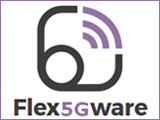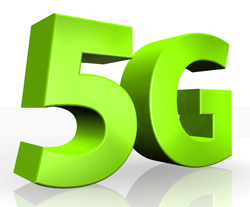Over the last year IMDEA Networks researchers have been part of Flex5Gware, a project launched as part of the joint European effort to make 5G communications a reality by the year 2020. IMDEA Networks has established itself firmly at the heart of the global 5G research community leading up to the hyper-connected, network society of the not-far-off future. With the tantalizing promise of a thousand times more network capacity, 5G is an unquestionable landmark in the global competition for technological leadership.
 One of the main objectives of Flex5Gware* is to pin point specific implementation challenges for 5G hardware (HW) and software (SW) platforms, targeting both network elements and devices. This analysis of the complexity associated to the implementation of 5G in real-world scenarios is used, for example, to indicate the viability of anticipated solutions for 5G. In particular, Flex5Gware is focusing on providing a proof-of-concept (PoC) of the key building blocks that 5G HW/SW platforms will be composed of. With its 11 PoCs, Flex5Gware covers the whole value chain of 5G platforms: starting from the antenna, RF modules and mixed signal stages and going up to digital HW and SW aspects.
One of the main objectives of Flex5Gware* is to pin point specific implementation challenges for 5G hardware (HW) and software (SW) platforms, targeting both network elements and devices. This analysis of the complexity associated to the implementation of 5G in real-world scenarios is used, for example, to indicate the viability of anticipated solutions for 5G. In particular, Flex5Gware is focusing on providing a proof-of-concept (PoC) of the key building blocks that 5G HW/SW platforms will be composed of. With its 11 PoCs, Flex5Gware covers the whole value chain of 5G platforms: starting from the antenna, RF modules and mixed signal stages and going up to digital HW and SW aspects.
At the end of its first year of work, besides producing a complete description of all Flex5Gware PoCs in terms of the technology to be used, listing the test objects, and mapping them to 5G use cases, Flex5Gware has achieved outstanding results for its PoCs: already 5 of them were showcased at the recent EuCNC Athens conference, presenting HW/SW enablers for 5G. Improvements in terms of reduced cost and footprint for the analogue hardware along with increased flexibility and reduced energy techniques based on context awareness were shown at the Flex5Gware booth. Among these 5 PoCs, the Flex5Gware consortium considers this year’s highlight the so-called “Full duplex transceiver”, a technology that provides up to 50% faster transmission rates for users and up to 21% more in the sum of transmission rates over all users in the cell (for a multiuser setting and compared to settings in which “full duplex” is not available).
IMDEA Networks researchers Dr. Vincenzo Mancuso and Dr. Domenico Giustiniano have specifically contributed to the project's achievements by producing key results on the integration of novel methodologies to extract timing information for user positioning algorithms, using GPS and WiFi technologies, and for the control of novel opportunistic device-to-device communications based on multi-path technologies. IMDEA's results are fundamental for the implementation of future "anticipatory" networks that automatically adapt upon sensing the presence of users.
Influencing global 5G standards
 IMDEA Networks has adopted a leading role in the development of 5G technologies such as mmWave communications, Network Function Virtualization and Software Defined 5G Networks,. The Flex5Gware project complements other existing research programmes at the Institute, such as the ERC Consolidator Grant SEARCHLIGHT, the EU H2020 projects mmMAGIC and MONROE, one national initiative HyperAdapt and another within the scope of the Madrid region, TIGRE5-CM. Together with the leading role of Dr. Arturo Azcorra, IMDEA Networks’ Director and President of the 5G Expert Group of the NetWorld2020 European Technology Platform, they constitute a powerful vehicle for influencing global 5G standards.
IMDEA Networks has adopted a leading role in the development of 5G technologies such as mmWave communications, Network Function Virtualization and Software Defined 5G Networks,. The Flex5Gware project complements other existing research programmes at the Institute, such as the ERC Consolidator Grant SEARCHLIGHT, the EU H2020 projects mmMAGIC and MONROE, one national initiative HyperAdapt and another within the scope of the Madrid region, TIGRE5-CM. Together with the leading role of Dr. Arturo Azcorra, IMDEA Networks’ Director and President of the 5G Expert Group of the NetWorld2020 European Technology Platform, they constitute a powerful vehicle for influencing global 5G standards.
The Flex5Gware project is co-funded by the European Commission’s 5G PPP program and it will operate until the summer of 2017. The consortium brings together major vendors of networking components and devices (Ericsson, Intel, NEC, Sequans), a major European operator (Telecom Italia), leading research-focused organizations (CEA, Fraunhofer Institute for Applied Solid State Physics IAF, IMDEA Networks, CNIT, CTTC, iMinds, Nokia Bell Labs, VTT Technical Research Centre of Finland), universities (Lund, Pisa, Leuven and Carlos III of Madrid) and academic bodies (CNIT), as well as two small-to-medium size enterprises (TNT - Tecnologías, Servicios Telemáticos y Sistemas S.A. and WINGS ICT Solutions).
* Flex5Gware stands for “Flexible and efficient hardware/software platforms for 5G network elements and devices”
- Visit the project website at http://5g-ppp.eu/flex5gware/
- IMDEA Networks research projects: Flex5Gware
- Media coverage of our work on 5G

